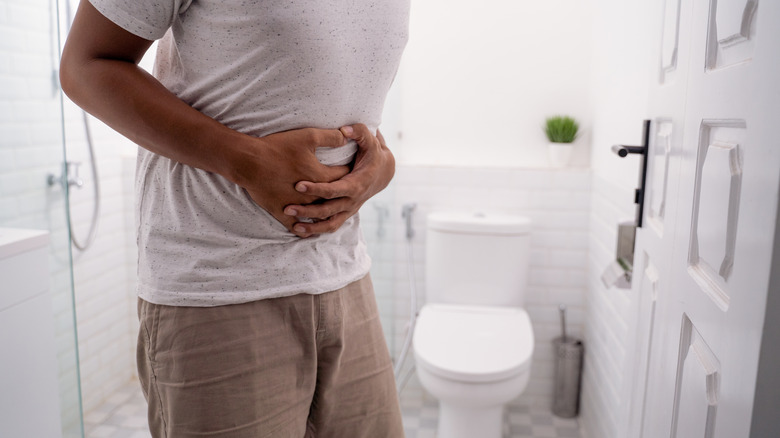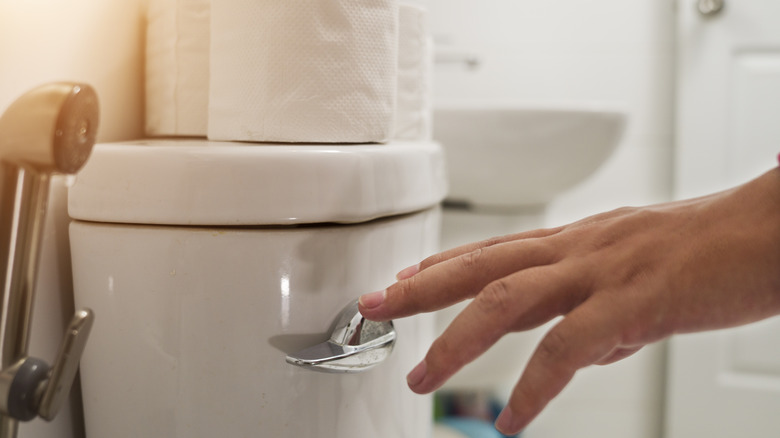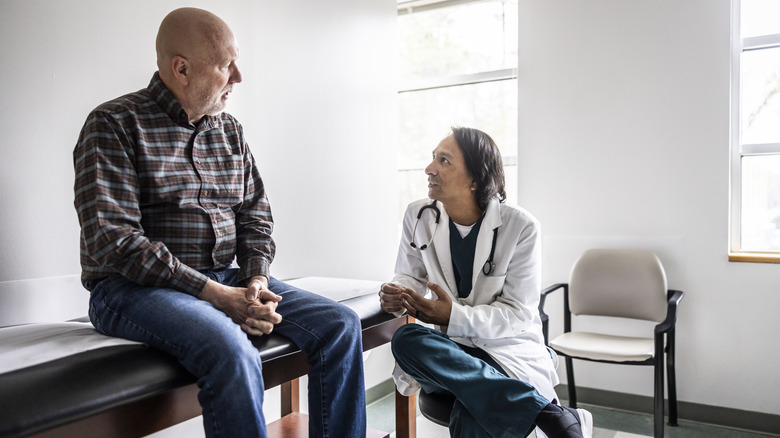What It Means When It Takes A While For Men To Start Peeing
Every once in a while, you might feel the urge to pee but find that it takes a moment or two to get things flowing. Maybe it's the awkwardness that comes with using a public restroom or it's your friend or family member who's talking to you through the door, but the occasional delayed start, otherwise known as "urinary hesitancy," is not entirely unusual. It can become an ongoing problem, however, for people with prostates.
People who experience urinary hesitancy may find it hard to start peeing or to maintain an uninterrupted urine stream or they may be unable to fully empty the bladder. While people with vaginas can also be affected by urinary hesitancy, most cases are observed in men, according to experts at Cedars Sinai. Causes may include the use of certain types of drugs, such as some antidepressants or pseudoephedrine, both of which can hinder bladder relaxation. Alternatively, some neurological disorders, like multiple sclerosis, may interfere with communication between the brain and the bladder, making it hard to know when there's a need to pee. More often than not, however, most cases of urinary hesitancy can be traced to one cause in particular.
Urinary hesitancy may be a side effect of prostate issues
Urologist Dr. Karyn S. Eilber told Cedars Sinai that urinary hesitancy in men is often the result of an enlarged prostate, also referred to as "benign prostatic hyperplasia." Urinary hesitancy is one of a series of lower urinary tract symptoms (LUTS) that characterize this condition. Other symptoms include nocturia, weak urine stream, and urinary urgency. It's the urethra that moves urine out of the body, but because the prostate is situated around the urethra, the gland's growth can impede the flow of urine through the already narrow tube. According to updated 2024 information published in StatPearls, this type of noncancerous prostate growth affects as many as 90% of men in their 70s and older.
Another condition associated with urinary hesitancy is acute bacterial prostatitis, as outlined in a 2016 research article published in American Family Physician. Pelvic pain and lower urinary tract symptoms are often initial signs of the prostate gland infection, which may progress into fever, nausea, and chills. This type of infection, thought to account for roughly 10% of all prostatitis cases, can be brought on by various strains of bacteria. When paired with adequate hydration and pain-relief methods, acute bacterial prostatitis generally resolves with antibiotic treatment. In more severe cases, hospitalization or intravenous antibiotic treatment may be required.
Health risks associated with untreated urinary hesitancy
A slow start to urination may not initially appear as cause for concern, but it's important to see a healthcare provider before the situation potentially worsens. "If someone notices progressive difficulty urinating, it's important to be seen by a doctor before they are unable to urinate at all," Dr. Eilber told Cedars Sinai. Otherwise, a person stands at an increased risk for bladder infections or kidney damage. Depending on the cause of one's urinary hesitancy, treatment options may be different. Medications may be used to reduce the size of the prostate or relax the urethral sphincters. Taking hot baths may also be suggested to help relax one's pelvic floor muscles. Establishing set bathroom breaks approximately every three hours (known as timed voiding) may also make peeing easier by protecting against a full bladder.
Even if you're not experiencing urinary hesitancy, the National Institute on Aging shares a number of ways we can keep up the strength and health of our bladder throughout our lives. This includes drinking plenty of water, allowing enough time for full emptying of the bladder, peeing after sexual intercourse, and eating a healthy diet of constipation-fighting foods.



